|
|
|
|
|
| |
Quality general dental care with an emphasis on natural esthetics, form and function. Experience with complex restorative, prosthetic and implant treatment.
----------------------------------------------------------------------------------------
TOOTH WHITENING
Tooth whitening, also known as Dental bleaching, is a common dental procedure. As a person ages the adult teeth often become darker due to changes in the mineral structure of the tooth, and become stained by bacterial pigments, foodstuffs (coffee, tea, caramel colored sodas and colored beverages, red wines) and tobacco. Certain antibiotic medications (like tetracycline) can also cause teeth to darken.
How does bleaching teeth work?
Oxidizing agents such as hydrogen peroxide or carbamide peroxide are used to lighten the shade of the tooth by bleaching (oxidizing) the staining pigments in the enamel surface. The oxidizing agent penetrates the porosities in the rod-like crystal structure of enamel and oxidizes interprismatic stain deposits; over a period of time, the dentin layer, lying underneath the enamel, is also bleached.
Power bleaching uses light energy to accelerate the process of bleaching in a dental office. The effects of bleaching can last for several months, but may vary depending on the lifestyle of the patient. Factors that decrease whitening include smoking and the ingestion of dark colored liquids like coffee, tea and red wine.
Internal staining of dentine can discolor the teeth from inside out. Internal bleaching can remedy this. If heavy staining or tetracycline damage is present on a patient's teeth, and whitening is ineffective, there are other methods of whitening teeth. Bonding, when a thin coating of composite material is applied to the front of a person's teeth and then cured with a blue light can be performed to mask the staining. A veneer can also mask tooth discoloration.
There are two main methods of gel bleaching—one performed with high-concentration gel, and another with low-concentration agents. High-concentration bleaching can be accomplished either in the dental office, or at home using custom trays. Performing the procedure at home is accomplished using high-concentration carbamide peroxide. Whitening is performed by applying a high concentration of oxidizing agent to the teeth with custom trays for short periods of time. The application trays ideally should be well-fitted to retain the bleaching gel, ensuring even and full tooth exposure to the gel. Trays will typically stay on the teeth for about 30-60 minutes. The procedure is repeated daily and may take several weeks depending on how dark the patients teeth are.
Most in-office bleaching procedures use a light-cured protective layer that is carefully painted on the gums and papilla (the tips of the gums between the teeth) to reduce the risk of chemical burns to the soft tissues. The bleaching agent is either carbamide peroxide, which breaks down in the mouth to form hydrogen peroxide, or hydrogen peroxide itself. The bleaching gel typically contains between 10% and 44% carbamide peroxide, which is roughly equivalent to a 3-10% hydrogen peroxide concentration.
Low-concentration whitening is far less effective, and is generally only performed at home. Low-concentration whitening involves purchasing over the counter strips that hold a relatively low concentration of bleaching agent next to the teeth for longer periods of time.
Results can vary, depending on which application is chosen, with some people achieving whiter teeth in a few days, and others seeing very little results or no results at all. Whitening is potentially better at a dentist because the strip or mouth-guard does not completely conform to the shape of the teeth, sometimes leaving the tips of the teeth (near the gumline) unbleached. The bleaching agent is typically less than 10% hydrogen peroxide equivalent, so irritation to the soft tissue around teeth is minimized. Dentists as well as some dental laboratories can fabricate custom fitted whitening trays that will greatly improve the results achieved with an over-the-counter whitening method.
Power or light-accelerated bleaching, sometimes colloquially referred to as laser bleaching, uses light energy to accelerate the process of bleaching in a dental office. Different types of energy can be used in this procedure, with the most common being halogen, LED, or plasma arc. Clinical trials have demonstrated that among these three options, halogen light is the best source for producing optimal treatment results. The ideal source of energy should be high energy to excite the peroxide molecules without overheating the pulp of the tooth. Lights are typically within the blue light spectrum as this has been found to contain the most effective wavelengths for initiating the hydrogen peroxide reaction. A power bleaching treatment typically involves isolation of soft tissue with a resin-based, light-curable barrier, application of a professional dental-grade hydrogen peroxide whitening gel (25-38% hydrogen peroxide), and exposure to the light source for 6–15 minutes at a time before the bleaching gel is changed and several applications are performed in a single appointment.
Bleaching methods:
There are many methods to whiten teeth: bleaching strips, at home delivered bleaching gel in trays and in-office light assisted power bleaching.
At-home whitening can also be done by applying small strips that go over the front teeth. Although these are less expensive then dentist administered bleaching in custom trays, they do not adapt to the teeth well and may result in uneven whitening of the teeth and do not contain solutions as strong as can be provided by a dentist in a tray. Additionally, they only cover the front six teeth and may not cover enough teeth for as proper result.
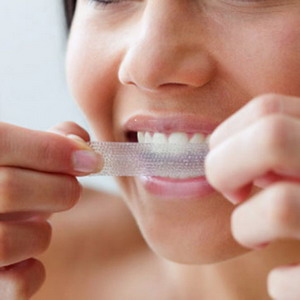
Patient applying over the counter whitening strips.
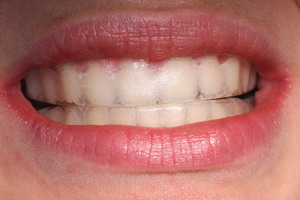
Patient wearing over the counter whitening strips.
Traditionally, at-home whitening involves applying bleaching gel to the teeth using custom trays. These custom trays allow bleaching solution to be applied evenly to all the teeth in the arch with stronger bleaching agents providing better results. Typically, the patient wears the bleaching trays for one hour daily and after several weeks results are achieved.

Transparent bleaching tray.
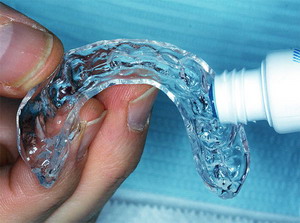
Bleaching gel is placed into the tray.
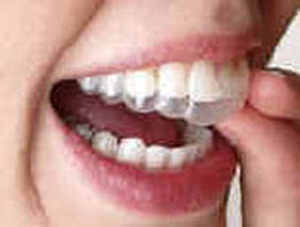
The bleaching gel filled custom tray is inserted.
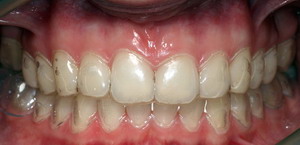
The custom bleaching trays are nearly invisible when worn.
In-office bleaching is done in a single visit using stronger bleaching solutions and is usually light assisted. This requires that the teeth and gums be isolated so that the bleaching gel can not burn the gum tissue. Treatment time usually is between 60 and 90 minutes. This type of bleaching can provide more dramatic results in less time.

ZOOM bleaching unit being applied to the teeth after isolation and application of the bleaching gel.
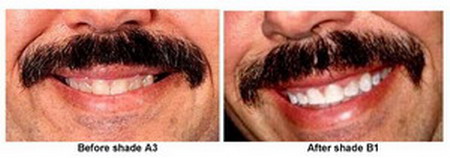
Case showing a shade change of 8 shades in a single appointment
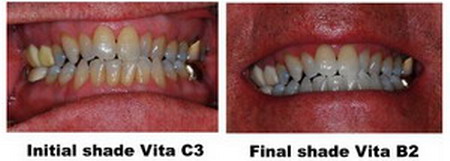
Case showing a shade change of 5 shades in a single appointment
Implant Cosmetic Dental Center™
----------------------------------------------------------------------------------------
Dr. Gregori M. Kurtzman is an international lecturer, selected as one of the top 100 dental speakers since 2006 by Dentistry Today, author of over 200 professional articles, a consultant to multiple dental manufacturers for product evaluation, development and research, he provides general dental care in suburban Maryland since 1986.
|
|
|
|
|
|
|
|
|